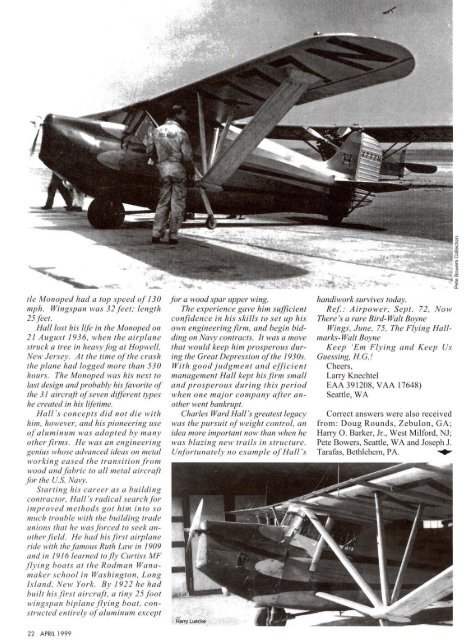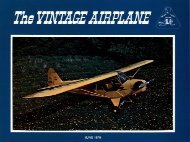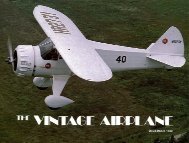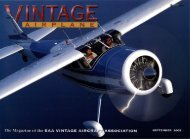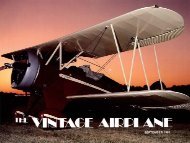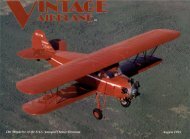VA Vol 27 No 4 April 1999 - Members Only
VA Vol 27 No 4 April 1999 - Members Only
VA Vol 27 No 4 April 1999 - Members Only
Create successful ePaper yourself
Turn your PDF publications into a flip-book with our unique Google optimized e-Paper software.
tle Monoped had a top speed of 130<br />
mph. Wingspan was 32 feet; length<br />
25 feet.<br />
Hall lost his life in the Monoped on<br />
21 August 1936, when th e airplane<br />
struck a tree in heavy fog at Hopwell,<br />
New Jersey. At the time ofthe crash<br />
th e plane had logged more than 530<br />
hours. The Monoped was his next to<br />
last design and probably his favorite of<br />
the 31 aircraft ofseven different types<br />
he created in his lifetime.<br />
Hal/ 's concepts did not die with<br />
him, however, and his pioneering use<br />
ofaluminum was adopted by many<br />
other firms. He was an engineering<br />
genius whose advanced ideas on metal<br />
working eased the transition from<br />
wood andfabric to all metal aircraft<br />
for the u.s. Navy.<br />
Starting his career as a building<br />
contractor, Hall 's radical search for<br />
improved methods got him into so<br />
much trouble with the building trade<br />
unions that he was forced to seek anotherfield.<br />
He had his first airplane<br />
ride with the famous Ruth Law in 1909<br />
and in 1916 learned to fly Curtiss MF<br />
flying boats at the Rodman Wanamaker<br />
school in Washington, Long<br />
Island, New York. By 1922 he had<br />
built his first aircraft, a tiny 25 foot<br />
wingspan biplane flying boat, constructed<br />
entirely ofaluminum except<br />
22 APRIL <strong>1999</strong><br />
for a wood spar upper wing.<br />
The experience gave him sufficient<br />
confidence in his skills to set up his<br />
own engineering firm, and begin bidding<br />
on Navy contracts. It was a move<br />
that would keep him prosperous during<br />
the Great Depression ofthe 1930s.<br />
With good judgment and efficient<br />
management Hall kept his firm small<br />
and prosperous during this p eriod<br />
when one major company after another<br />
went bankrupt.<br />
Charles Ward Hall's greatest legacy<br />
was th e pursuit ofweight control, an<br />
idea more important now than when he<br />
was blazing new trails in structure.<br />
Unfortunately no example ofHall's<br />
• Hany Luecke_<br />
handiwork survives today.<br />
Ref: Airpower, Sept. 72 , <strong>No</strong>w<br />
There's a rare Bird-Walt Boyne<br />
Wings, June, 75, Th e Flying Hallmarks-Walt<br />
Boyne<br />
Keep 'Em Flying and Keep Us<br />
Guessing, H.G,!<br />
Cheers,<br />
Larry Knechtel<br />
EAA 391208, <strong>VA</strong>A 17648)<br />
Seattle, WA<br />
Correct answers were also received<br />
from: Doug Rounds, Zebulon, GA ;<br />
Harry O. Barker, Jr., West Milford, NJ;<br />
Pete Bowers, Seattle, W A and Joseph J.<br />
Tarafas, Bethlehem, P A. ......


